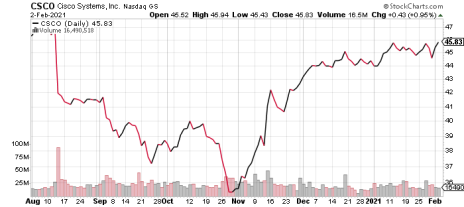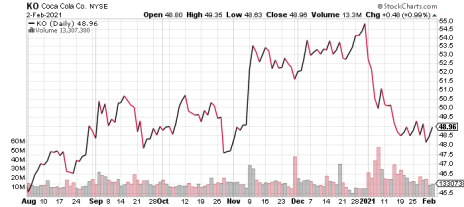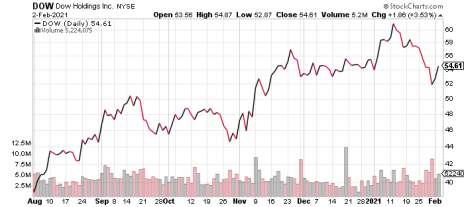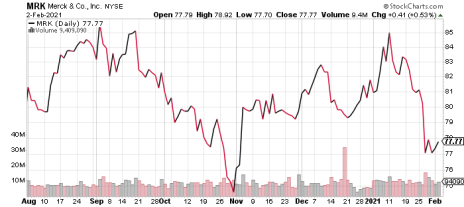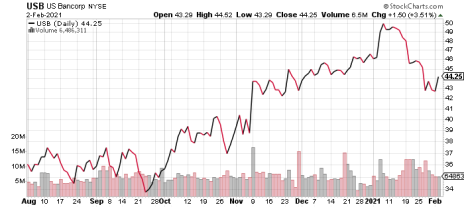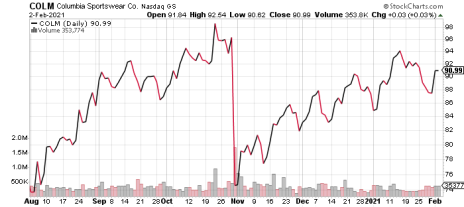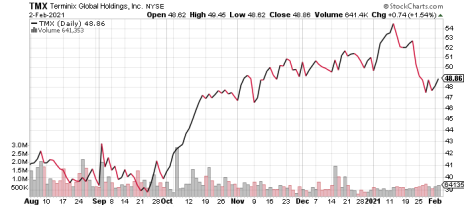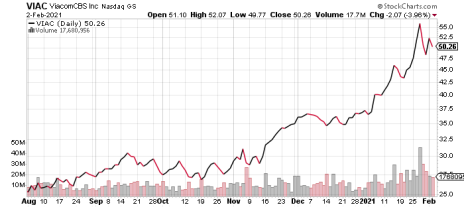Thank you for subscribing to the Cabot Undervalued Stocks Advisor. We hope you enjoy reading the February 2021 issue.
We briefly comment on how the response by hedge funds to the Reddit trades may have led to last week’s sell-off and this week’s rebound in the stock market. Is there a bubble? Yes, and our note touches upon how all four ingredients of a bubble, outlined in a recent book on bubbles, are in place.
Earnings season is upon us. We review the reports from Dow (DOW) and JetBlue (JBLU), and look forward to six more reports in the coming week.
Please feel free to send me your questions and comments. This newsletter is written for you and the best way to get more out of the letter is to let me know what you are looking for.
I’m best reachable at Bruce@CabotWealth.com. I’ll do my best to respond as quickly as possible.
Cabot Undervalued Stocks Advisor 221
[premium_html_toc post_id="224901"]
And Away We Go...
Investors and commentators seemed a bit troubled by the emerging power of the Reddit crowd, the trade-at-home “renegades” who drive highly-shorted stocks like GameStop (GME), AMC Entertainment (AMC), Koss Corporation (KOSS) and others to prices well beyond the orbit of their troubled underlying fundamentals.
Yet, other than a few bruised hedge fund manager egos (and balance sheets), the effect on the broader stock market appears to be fleeting. Even last week’s slippage in the S&P 500 could easily be attributed to temporary and technical knock-on effects. Jacob Mintz, chief analyst for the Cabot Options Trader, described how many hedge funds aggressively reduced their risk postures last week, selling highly liquid stocks to fund their short-covering (buying back stocks they had shorted, in fear of being on the wrong side of the Reddit crowd).
With the now-infamous Reddit trades unraveling (GME is now down about 75% from its peak) and the hedge fund adjustments mostly completed, the market is free to rebound. And so it has, posting (so far) back-to-back 1.6% daily gains on Monday and Tuesday (through mid-day Tuesday).
Where does this leave the bubble worries? We think the market is in some type of bubble. It fits four criteria, described in William Quinn and John Turner’s recent book Boom and Bust: A Global History of Financial Bubbles. These include marketability (ease of trading), which might be considered the oxygen of a bubble; plenty of easy and cheap money, the fuel of a bubble; rush of enthusiastic speculation, the heat of a bubble; and an appealing narrative, the spark that ignites it all. All four of these are present today.
Historically, bubbles don’t pop early. They gradually inflate for years, then tend to go parabolic, prior to bursting. Our current bubble could easily continue for many more years. Investors sense that the easy money will continue to flow, earnings will remain robust and few impediments will crop up. With apologies to both Jackie Gleason and Ian McShane’s character “Winston” in the John Wick series, “and away we go….”
Next week, we’ll highlight some strategies for investing during a bubble.
Feel free to listen to your companies’ quarterly management earnings calls, as these are available to the public. These calls provide valuable color on what happened in the quarter, management’s outlook and what Wall Street analysts are currently thinking about. To access the calls, visit the company’s investor relations pages.
Share prices in the table reflect Tuesday (February 2) closing prices. Please note that prices in the discussion below are based on mid-day February 2 prices.
Note to new subscribers: You can find additional color on recent earnings and other news on recommended companies in prior editions of the Cabot Undervalued Stocks Advisor on the Cabot website.
Send questions and comments to Bruce@CabotWealth.com.
Upcoming Earnings Releases
February 4: Bristol Myers (BMY)
February 4: Merck (MRK)
February 4: Columbia Sportswear (COLM)
February 9: Cisco (CSCO)
February 10: Coca-Cola (KO)
February 10: General Motors (GM)
February 11: Tyson (TSN)
February 11: Molson Coors (TAP)
Today’s Portfolio changes
None
Portfolio changes during the past month
Viacom (VIAC) – raising price target from 48 to 54.
General Motors (GM) – raising price target from 49 to 62.
Bristol-Myers Squibb (BMY) – raising from Buy to Strong Buy.
ViacomCBS (VIAC) – raising price target from 43 to 48.
Columbia Sportswear (COLM) – reducing from Buy to Hold.
Terminix Holdings (TMX) – reducing from Buy to Hold.
Equitable Holdings (EQH) – reducing from Hold to Sell.
Growth & Income Portfolio
Growth & Income Portfolio stocks are generally higher-quality, larger-cap companies that have fallen out of favor. They usually have some combination of attractive earnings growth and an above-average dividend yield. Risk levels tend to be relatively moderate, with reasonable debt levels and modest share valuations.
| Stock (Symbol) | Date Added | Price Added | 2/2/21 | Capital Gain/Loss | Current Dividend Yield | Price Target | Rating |
| Bristol-Myers Squibb (BMY) | 04-01-20 | 55 | 63 | 15.3% | 3.1% | 78 | Strong Buy |
| Cisco Systems (CSCO) | 11-18-20 | 42 | 46 | 8.6% | 3.1% | 55 | Buy |
| Coca-Cola (KO) | 11-11-20 | 54 | 49 | -9.2% | 3.3% | 64 | Buy |
| Dow Inc (DOW) | 06-05-18 | 68 | 55 | -20.1% | 5.1% | 60 | Hold |
| Merck (MRK) | 12-9-20 | 83 | 78 | -6.3% | 3.3% | 105 | Buy |
| Tyson Foods (TSN) | 12-10-19 | 89 | 64 | -27.9% | 2.8% | 75 | Buy |
| US Bancorp (USB | 12-29-20 | 46 | 44 | -4.4% | 3.8% | 58 | Buy |
Bristol Myers Squibb Company (BMY) is a New York-based global biopharmaceutical company. In November 2019, the company acquired Celgene for a total value of $80.3 billion. We are looking for Bristol Myers to return to overall revenue growth, both from resilience in their key franchises (Opdivo, Revlimid and Eliquis) and from new products currently in their pipeline. We also want to see the company execute on its $2.5 billion cost-cutting program which will likely remain intact with the MyoKardia acquisition.
Bristol Myers reports earnings on Thursday, with the consensus earnings estimate at $1.42.
BMY shares fell 1% in the past week and have about 21% upside to our 78 price target.
The stock trades at a low 8.6x estimated 2021 earnings of $7.45 (up a cent from last week). Bristol’s fundamental strength, low valuation and 3.0% dividend yield that is well-covered by enormous free cash flow makes a compelling story. STRONG BUY.
Cisco Systems (CSCO) generated about 72% of its $48 billion in revenues from equipment sales, including gear that connects and manages data and communications networks. Other revenues are generated from application software, security software and related services, providing customers a valuable one-stop-shop. Cisco is shifting toward a software and subscription model and ramping new products, helped by its strong reputation and its entrenched position within its customers’ infrastructure.
The emergence of cloud computing has reduced the need for Cisco’s gear, leading to a stagnant/depressed share price. Cisco’s prospects are starting to improve under CEO Chuck Robbins (since 2015). The company is highly profitable, generates vast cash flow (which it returns to shareholders through dividends and buybacks) and carries $30 billion in cash, double the $14.6 billion in total debt.
Cisco will report earnings next Wednesday. The consensus earnings estimate is $0.75/share. On February 10, investors can listen in on the company’s presentation at the Goldman Sachs Technology and Internet Conference, which can be accessed through Cisco’s investor relations page.
CSCO shares rose 2% in the past week, and have about 20% upside to our 55 price target. The shares trade at a low 14.4x estimated FY2021 earnings of $3.17. This estimate, and the FY2022 estimate, were unchanged in the past week. On an EV/EBITDA basis on FY2021 estimates, the shares trade at a discounted 9.9x multiple. CSCO shares offer a 3.1% dividend yield. BUY.
Coca-Cola (KO) is best known for its iconic soft drinks but nearly 40% of its revenues come from non-soda brands across the non-alcoholic spectrum, including PowerAde, Fuze Tea, Glaceau, Dasani, Minute Maid and Schweppes. Its vast global distribution system offers it the capability of reaching essentially every human on the planet.
While the near-term outlook is clouded by pandemic-related stay-at-home restrictions, secular trends away from sugary sodas, high exposure to foreign currencies (now perhaps a positive) and always-aggressive competition, Coca-Cola’s longer-term picture looks bright. Relatively new CEO James Quincey (2017), a highly-regarded company veteran with a track record of producing profit growth and making successful acquisitions, is reinvigorating the company by narrowing its oversized brand portfolio, boosting its innovation and improving its efficiency. The company is also working to improve its image (and reality) of selling sugar-intensive beverages that are packaged in environmentally-insensitive plastic. Coca-Cola is supported by over $21 billion in cash which offsets much of its $53 billion in debt. Its growth investing, debt service and $0.41/share quarterly dividend are well covered by free cash flow.
Coca-Cola reports earnings on February 10, with the consensus earnings estimate at $0.42/share.
KO shares rose 1% in the past week, showing more stability following downgrades from several brokerage firms around New Year’s. The stock has about 30% upside to our 64 price target. While the valuation is not statistically cheap, at 23.6x estimated 2021 earnings of $2.09 and 21.6x estimated 2022 earnings of $2.28 (both estimates slipped a cent in the past week), the shares are undervalued while also offering an attractive 3.3% dividend yield. BUY.
Dow Inc. (DOW) merged with DuPont in 2017 to temporarily create DowDuPont, then split into three companies in 2019 based roughly along product lines. The new Dow is the world’s largest producer of ethylene/polyethylene, the most widely-used plastics. Dow is primarily a cash-flow story driven by three forces: 1) petrochemical prices, which are often correlated with oil prices and global growth, along with competitors’ production volumes; 2) volume sold, largely driven by global economic conditions; and 3) ongoing efficiency improvements (a never-ending quest of all commodity companies to maintain their margins).
Dow reported fourth-quarter earnings of $0.84/share, well-ahead of the consensus estimate of $0.67/share. Overall, a strong quarter for Dow.
Revenues grew 5% compared to a year ago, with higher prices (+2%) and volumes (+1%), helped by a modest currency tailwind (+2%). The company and its markets have moved beyond the pandemic, as volumes reached pre-pandemic levels in all of Dow’s operating segments. As its commodity chemicals are widely-used across the global economy, this is encouraging even as the news is filled with grim Covid statistics.
Equity earnings rose to $106 million from a $(21) million loss a year ago. These earnings reflect Dow’s share of profits from its Sadara, Kuwait and Thailand joint ventures. The large improvement is due to Sadara, its joint venture with Saudi Arabia (which produced a $3 million profit compared to a $132 million loss a year ago). Sadara is an enormous petrochemical facility that was recently completed after a complicated, multi-year construction project. The venture should no longer require cash infusions.
Operating profits rose about 2%, so margins compressed to 9.8% from 10.1% a year ago. While overall pricing improved, weaker profits from its siloxanes (used as a softener) materials weighed on profits. The company produced $1.4 billion in free cash flow for the quarter, and a total of $5 billion for the full year, more than 4x the prior year. Dow reduced its debt net of cash by $2.6 billion during the year – impressive even without a pandemic. The company provided a moderately encouraging 2021 outlook, with higher revenues and profits, along with another $1 billion in net debt reduction.
Dow shares fell 6% this past week and have 11% upside to our 60 price target. Without any additional positive news, we are reluctant to increase our price target, yet we’re also reluctant to sell too soon in this strong market. The shares trade at 15.4x estimated 2022 earnings of $3.50, although these earnings are more than a year away. This estimate ticked up about 3% for the second consecutive week. Notably, the 2021 estimate jumped 11% after the earnings release.
The high 5.2% dividend yield is particularly appealing for income-oriented investors. Dow currently is more than covering its dividend and management makes a convincing case that it will be sustained. HOLD.
Merck (MRK) – Pharmaceutical maker Merck focuses on oncology, vaccines, antibiotics and animal health. Keytruda, a blockbuster oncology treatment representing about 30% of total revenues, holds an impressive franchise that is growing at a 20+% annual rate.
To tighten its focus, Merck will spin off its Women’s Health business, along with its biosimilars and various legacy brands, by mid-year 2021. These businesses currently generate roughly 15% of Merck’s total revenues yet comprise half of its product roster. Merck also recently divested its stake in vaccine maker Moderna. Given the high valuations of other animal health businesses like Elanco and Zoetis, we would not be surprised to see Merck spin off or divest its animal health business. Merck has a solid balance sheet and is highly profitable.
Primary risks include its dependence on the Keytruda franchise, possible generic competition for its Januvia diabetes treatment starting in 2022, and the possibility of government price controls.
Merck added a new board member, Dr. Stephen Mayo, a professor of biology and chemistry at the California Institute of Technology. He joins the board immediately and will be on the May 2021 proxy for re-election. He seems like a highly-qualified addition.
Merch reports earnings on February 4, with the consensus earnings estimate at $1.39.
Merck shares slipped 3% this past week and have about 34% upside to our 105 price target. Valuation is an attractive 12.5x this year’s estimated earnings of $6.31 (estimate unchanged this past week). The 3.3% dividend yield offers additional income-oriented investors. Merck produces generous free cash flow to fund this dividend as well as likely future dividend increases. BUY
Tyson Foods (TSN) is one of the world’s largest food companies, with over $42 billion in revenues last year. Beef products generate about 36% of total revenues, while chicken (31%), pork (10%), and prepared/other contribute the remaining revenues. It has the #1 domestic position in beef and chicken with roughly 21% market share in each. Its well-known brands include Tyson, Jimmy Dean, Hillshire Farms, Ball Park, Wright and Aidells. Tyson’s long-term growth strategy is to participate in the growing global demand for protein. The company has more work to do to convince investors that its future is brighter, particularly as it is more of a commodity company (and thus has lower margins) compared to its food processor peers.
The company, along with two other major poultry producers, is under investigation by a U.S. congressional panel for violations of worker safety during the pandemic. We anticipate that little new information will come from this investigation.
Fortune magazine recently ranked Tyson at the #1 Most Admired Food Production Company for the fifth consecutive year. We’re not sure what, if anything, to make of this, although it certainly doesn’t hurt to have the top ranking.
The stock slipped 5% in the past week and has about 18% upside to our 75 price target. Valuation is attractive at 11.2x estimated 2021 earnings of $5.69. This estimate was unchanged this past week. Currently the stock offers a 2.8% dividend yield. BUY.
U.S. Bancorp (USB), with a $70 billion market value, is the one of the largest banks in the country. It focuses is on consumer and commercial banking through its 2,730 branches in the Midwest, southwest and western United States. It also offers a range of wealth management and payments services. Unlike majors JP Morgan, Bank of America and Goldman Sachs, U.S. Bancorp has essentially no investment banking or trading operations.
USB shares remain out of favor due to worries about a potential surge in pandemic-driven credit losses and weaker earnings due to the low interest rate environment.
However, U.S. Bancorp is one of the best-run banks in the country and is long-known for its conservative lending. Also, unlike the prior cycle, home mortgage lending today is a source of credit strength. U.S. Bancorp has a solid capital base, bolstered by its sizeable credit loss reserves of 2.7% of total loans. The bank also maintains one of the best expense ratios in the industry.
Recent fourth quarter earnings were healthy and reflect the bank’s enduring strength in its profitability, capital and credit reserves. But, the shares fell on the news, in line with most other banks, as investors expected more encouraging near-term results and a faster recovery.
U.S. Bancorp added Kimberly-Ellison Taylor to its board of directors. She is Oracle’s executive director of finance thought leadership and likely brings a valuable new perspective to the board.
The interest rate environment is improving, as the 10-year Treasury yield is now 1.12%, up from about 0.92% at year-end. Short-term interest rates have remained unchanged.
The shares fell about 3% in the past week and have about 31% upside to our 58 price target.
Valuation is a modest 10.5x estimated 2022 earnings of $4.22. This estimate rose 1 cent this past week. On a price/tangible book value basis, USB shares trade at a reasonable 1.8x multiple of the $24.85 tangible book value. This ratio ignores the value of its payments, investment management and other service businesses that have low tangible book values but produce steady and strong earnings. Currently the stock offers an appealing 3.8% dividend yield. BUY.
Buy Low Opportunities Portfolio
Buy Low Opportunities Portfolio stocks include a wide range of value opportunities, often with considerable upside. This group may include stocks across the quality and market cap spectrum, including those with relatively high levels of debt and a less-clear earnings outlook. The stocks may not pay a dividend. In all cases, the shares will trade at meaningful discounts to our estimate of fair value.
| Stock (Symbol) | Date Added | Price Added | 2/2/21 | Capital Gain/Loss | Current Dividend Yield | Price Target | Rating |
| Columbia Sportswear (COLM) | 06-30-20 | 80 | 91 | 13.7% | — | 100 | Hold |
| Equitable Holdings (EQH) | 11-15-19 | 24 | 25 | 6.9% | 2.7% | 28 | Sell |
| General Motors (GM) | 12-31-19 | 37 | 53 | 44.3% | — | 62 | Hold |
| JetBlue (JBLU) | 11-25-20 | 16 | 14 | -8.7% | — | 19 | Buy |
| Molson Coors (TAP) | 08-04-20 | 37 | 49 | 33.0% | — | 59 | Buy |
| Terminix Global Holdings (TMX) | 10-13-20 | 45 | 49 | 9.5% | — | 57 | Hold |
| ViacomCBS (VIAC) | 08-26-20 | 28 | 50 | 82.2% | 1.9% | 54 | Buy |
Columbia Sportswear (COLM) produces the highly recognizable Columbia brand outdoor and active lifestyle apparel and accessories, as well as SOREL, Mountain Hardware, and prAna products. For decades, the company was successfully led by the one-of-a-kind Gert Boyle, who passed away late last year. The Boyle family retains a 36% ownership stake and Gert’s son Timothy Boyle remains at the helm.
Columbia reports earnings on February 4, with the consensus earnings estimate at $1.29. After the highly disappointing third quarter, the pressure is on for Columbia to report strong results.
Columbia’s shares were flat this past week and have about 10% upside to our 100 price target. Valuation is 24.8x estimated 2021 earnings of $3.67 (estimate unchanged from last week). On 2022 estimated earnings of $4.62 (down two cents), the valuation is a more reasonable 19.7x. For comparison, the company earned $4.83/share in 2019. We recently moved the shares to a Hold as they are approaching our 100 price target. HOLD.
Equitable Holdings (EQH) owns two principal businesses: Equitable Financial Life Insurance Co. and a majority (65%) stake in AllianceBernstein Holdings L.P. (AB), a highly respected investment management and research firm. We recently moved EQH shares to a Sell, as they essentially reached our 28 price target. From here, the risk/reward appears unfavorable. We don’t see any particular fundamental issues at Equitable, and the 2.7% yield continues to offer some appeal. EQH shares rose 16% since the original recommendation and 43% since the CUSA analyst change at the end of June. SELL.
General Motors (GM) under CEO Mary Barra (since 2014) has transformed from a lumbering giant to a well-run and (almost) respected auto maker. The company has smartly exited many chronically unprofitable geographies (notably Europe) and trimmed its passenger car roster while boosting its North American market share with increasingly competitive vehicles, particularly light trucks. We consider its electric and autonomous vehicle efforts to be near industry-leading. We would say it is perhaps 75% of the way through its gas-powered vehicle turnaround, and is well-positioned but in the very early stages of its EV development. GM’s balance sheet is sturdy, with Automotive segment cash exceeding Automotive debt. Its credit operations are well-capitalized but may yet be tested as the pandemic unfolds.
General Motors reports earnings on February 10, with the consensus estimate at $1.69.
General Motors said it aspires to completely phase out the production of gas-powered vehicles by 2035. This is an aggressive goal, leaving only 15 years to fully transition from producing 7.7 million internal combustion engine vehicles, or ICEs, to 7.7 million electric vehicles. Given the capital spending, engineering complexities, economics, the need for a fully-global charging infrastructure, significant government subsidies and unclear consumer demand, we think this target is more of Mary Barra “setting the right tone” rather than a hard-n-fast requirement.
GM and truck maker Navistar (now owned by Volkswagen) will collaborate on the development of hydrogen fuel cells for commercial trucks.
The GM South Korea operations saw a 76% year-over-year increase in revenues, as it sold 36,000 units. While small, the SK operations have been a thorn in GM’s side for years – this news may help alleviate some of its pain.
GM shares slipped 2% in the past week as investors await the quarterly results following a huge surge in the stock to all-time, post-IPO highs. We see fair value at 62, so the shares have about 19% upside to our target price.
On a P/E basis, the shares trade at 8.6x estimated calendar 2021 earnings of $6.04 (up a cent this past week).
We recently raised our price target on GM to 62 from 49. Please see the January 20, 2021 Cabot Undervalued Stocks Advisor opening note for more commentary. HOLD.
JetBlue Airlines (JBLU) is a low-cost airlines company. Started in 1999, the company serves nearly 100 destinations in the United States, the Caribbean and Latin America. The company’s revenues of $8.1 billion in 2019 compared to about $45 billion for legacy carriers like United, American and Delta, and were about a third of Southwest Airlines ($22 billion). Its low fares and high customer service ratings have built strong brand loyalty, while low costs have helped JetBlue produce high margins. Its TrueBlue mileage awards program, which sells miles to credit card issuers, is a recurring source of profits.
We believe consumers (and eventually business travelers) are likely to return to flying. JetBlue has aggressively cut its cash outflow to endure through the downturn. Although its $4.8 billion debt is elevated, its $3.6 billion cash balance gives the airline plenty of time to recover. JBLU shares carry more risk than the typical CUSA stock.
JetBlue reported a fourth quarter loss of $(1.53)/shares, compared to a profit of $0.56/share in the pre-pandemic fourth quarter last year. The loss was better than the consensus estimate for a loss of $(1.66)/share. Revenue fell 67% from a year ago to $661 million, but was slightly better than the consensus estimate. However, investor expectations for the eventual recovery are being pushed out.
The company’s daily cash burn rate was about $6.7 million based on their methodology, and was at the low end of their guidance. While we understand their approach, which includes all-in cash burn including the inflows of new debt and equity, we think this is not the right way to calculate it. We would include only the cash outflows from losses, working capital and capital spending. Inflows from new debt and equity are how the cash burn hole is filled. Our approach shows a $7.1 million/day cash burn. Regardless, going forward the company will revert to reporting EBITDA, so investors will also focus on this metric. We will still look at cash burn using our definition.
Capacity fell 47%, and revenue per available seat mile (RASM, which measures average ticket prices) was $7.80, compared to $12.63 a year ago. Costs on a similar basis, excluding fuel, was $12.31, up from $8.31 a year ago. These were favorable results.
JetBlue anticipates EBITDA of negative $525 million to negative $625 million for the first quarter. Its current cash balance of $3.1 billion offers plenty of runway until revenues ramp up to a break-even cash burn rate, likely in early 2022. If customer demand in 2022 fully reaches the 2019 level, JetBlue should produce much larger profits than in 2019 due to its now-lower cost structure.
The company sounds pro-active in managing the business, with a common-sense approach, and is well-positioned for a demand recovery. Management is rolling out new services, reaching new markets, and continuing to upgrade its fleet. The primary wildcard is the speed of the demand recovery. We will patiently wait.
JBLU shares fell 2% this past week and have 32% upside to our 19 price target. The stock trades at 14.7x estimated 2022 earnings of $0.98 (this estimate fell 10% in the past week, reflects the slower traffic recovery rate and is volatile based on Covid case trends). The 2021 estimated loss per share continues to widen, now at $(2.45) as near-term Covid case trends have pushed a recovery out a quarter or more. On an EV/EBITDA basis, the shares trade at 5.6x estimated 2022 EBITDA. BUY.
Molson Coors Beverage Company (TAP) – The thesis for this company is straight-forward – a reasonably stable company whose shares sell at an overly-discounted price. One of the world’s largest beverage companies, Molson Coors produces the highly recognized Coors, Molson, Miller and Blue Moon brands as well as numerous local, craft and specialty beers. About two-thirds of its $10 billion in net revenues are produced in the United States, where it holds a 24% share of the beer market.
Investors’ primary worry about Molson Coors is its lack of meaningful (or any) revenue growth as it produces relatively few of the fast-growing hard seltzers and other trendier beverages. Our view is that the company’s revenues are resilient, it produces generous cash flow and is reducing its debt, traits that are value-accretive and underpriced by the market. A new CEO is helping improve its operating efficiency and expand carefully into more growthier products.
We anticipate that the company will resume paying a dividend mid-year, perhaps at a $0.35/share quarterly rate, which would provide a generous 2.8% yield.
Molson Coors reports earnings on February 11, with the consensus earnings estimate at $0.77/share.
TAP shares slipped 4% in the past week and have about 19% upside to our 59 price target.
Estimates were flat/down this past week. TAP shares trade at 11.7x estimated 2021 earnings of $4.21. This valuation is low, although not the stunning bargain from a few months ago.
On an EV/EBITDA basis, or enterprise value/cash operating profits, the shares trade for about 8.5 current year estimates, among the lowest valuations in the consumer staples group and well below other brewing companies.
For investors looking for a stable company trading at a low valuation, TAP shares continue to have contrarian appeal. Patience is the key with Molson Coors. We think the value is solid although it might take a year or two to be fully recognized by the market. BUY.
Terminix Global Holdings (TMX) is both a new company and an old company. While the name “Terminix” is one of the largest and most widely recognized names in pest control, the company previously was obscured inside of the ServiceMaster conglomerate. With the sale of ServiceMaster Brands, the company changed its name to Terminix. The company appears to have fully addressed its legal liability from deficient termite treatments, removing an overhang on its shares.
A new CEO, Brett Ponton, former head of Monro, joined in August 2020. His leadership at Monro led to sales growth and a strong recovery in its share price. Our expectation is that he will bring sales growth, operational efficiency and integrity to Terminix, ultimately leading to a higher share price. The company’s balance sheet is in good condition. Major risks include the possibility of higher litigation expenses, strong competition, and possible execution risks by the new leadership. TMX shares carry more risk than typical CUSA stocks.
There was no meaningful news on the company this past week.
Terminix shares were flat in the past week and have 16% remaining upside to our 57 price target.
Reliable consensus 2022 earnings estimates appear to be settling at around $1.43/share. This would put the TMX multiple at a high 34.3x, but we recognize that these types of companies generally are valued on EV/EBITDA. On this basis, the shares trade at about 18.5x EBITDA.
We recently moved the shares to a HOLD as they approached our price target. HOLD.
ViacomCBS (VIAC) is a major media and entertainment company, owning highly recognized properties including Nickelodeon, Comedy Central, MTV and BET, the Paramount movie studios, Showtime and all of the CBS-related media assets. The company’s brands are powerful and enduring, typically holding the #1 market shares in the highest-valued demographic groups in the country. ViacomCBS’ reach extends into 180 countries around the world. Viacom and CBS re-merged in late 2019 and are now under the capable leadership of former Viacom CEO Robert Bakish.
Viacom is being overhauled to stabilize its revenues, boost its relevancy for current/future viewing habits and improve its free cash flow. The company is shifting away from advertising (currently about 36% of revenues) and affiliate fees (currently about 39% of revenues), toward content licensing – essentially renting its vast library of movies, TV shows and other content to third-party firms like Netflix and others. Viacom is building out its own streaming channel (Paramount+) and other new distribution channels, which are generally showing fast growth. Ultimately, we think the company may be acquired by a major competitor, given its valuable businesses and content library, as well as its bite-sized market cap of about $20 billion.
Its challenges include the steady secular shift away from cable TV subscriptions, which is pressuring advertising and subscription revenues. The pandemic-related reductions in major sporting events are also weighing on VIAC shares. However, ViacomCBS’ extensive reach, strong market position and strategic value to other, much larger media companies, and its low share valuation, make the stock appealing.
There was no meaningful news on the company this week.
VIAC shares lifted another 6% this past week. Much of the run-up is due to enthusiasm over Viacom’s streaming service as well as perhaps recognition of its low valuation and the likelihood of a return to more advertising as the economy opens up. Also, the day-trader Reddit crowd likely pushed the shares up as well, as the price surged to nearly 61 last Wednesday and has fallen back to “trend” since then. The move was quick – it closed above our recently-raised 54 price target only on one day.
We had raised our price target to 54 to incorporate what appears to be higher earning power than we initially expected. VIAC shares have about 7% upside to this new target.
Valuation is currently at about 9.9x estimated 2022 EBITDA, which we believe undervalues the company’s impressive leadership and assets. On a price/earnings basis, VIAC shares trade at 11.0x estimated 2022 earnings of $4.59. ViacomCBS shares offer a sustainable 1.9% dividend yield and look attractive here. BUY
Strong Buy – This stock offers an unusually favorable risk/reward trade-off, often one that has been rated as a Buy yet the market has sold aggressively for temporary reasons. We recommend adding to existing positions.
Buy – This stock is worth buying.
Hold – The shares are worth keeping but the risk/return trade-off is not favorable enough for more buying nor unfavorable enough to warrant selling.
Retired – This stock has been removed from the portfolio, primarily for being fully valued. We generally view the company as fundamentally solid with few problems. Investors may choose to hold these shares to minimize portfolio turnover, seek to capture continued upward share price momentum, or other reasons.
Sell – This stock is approaching or has reached our price target, its value has become permanently impaired or changes in its risk or other traits warrant a sale.
The next Cabot Undervalued Stocks Advisor issue will be published on March 3, 2021.
Cabot Wealth Network
Publishing independent investment advice since 1970.
President & CEO: Ed Coburn
Chairman & Chief Investment Strategist: Timothy Lutts
176 North Street, PO Box 2049, Salem, MA 01970 USA
800-326-8826 | support@cabotwealth.com | CabotWealth.com
Copyright © 2021. All rights reserved. Copying or electronic transmission of this information is a violation of copyright law. For the protection of our subscribers, copyright violations will result in immediate termination of all subscriptions without refund. No Conflicts: Cabot Wealth Network exists to serve you, our readers. We derive 100% of our revenue, or close to it, from selling subscriptions to its publications. Neither Cabot Wealth Network nor our employees are compensated in any way by the companies whose stocks we recommend or providers of associated financial services. Disclaimer: Sources of information are believed to be reliable but they are not guaranteed to be complete or error-free. Recommendations, opinions or suggestions are given with the understanding that subscribers acting on information assume all risks involved. Buy/Sell Recommendations: All recommendations are made in regular issues or email alerts or updates and posted on the private subscriber web page. Performance: The performance of this portfolio is determined using the midpoint of the high and low on the day following the recommendation. Cabot’s policy is to sell any stock that shows a loss of 20% in a bull market or 15% in a bear market from the original purchase price, calculated using the current closing price. Subscribers should apply loss limits based on their own personal purchase prices.


